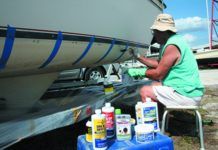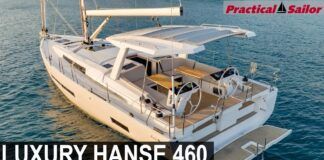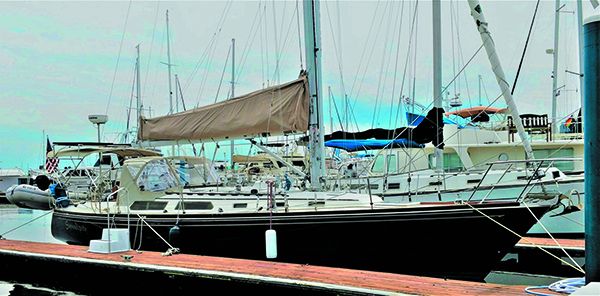
Lifesling Cautionary Tale
I want to add to the comments about Lifesling web failures (see PS August 2016 “Lifesling Webbing Beckets Fail”) Last summer, my wife and I were out for a casual weekend cruise on Chesapeake Bay. Having found a protected anchorage that appeared free of the pesky stinging nettles so common in the Bay, especially late in the summer, my wife decided to go for a vigorous swim. By the time she returned to the boat, she was exhausted and needed some help getting up our stern ladder. This seemed like a job where our Lifesling2 could easily be of assistance. However, once secured, as soon as I put tension on the rope, the webbing snapped.
Of course, I was shocked by this. Fortunately, the conditions were calm, and with some additional help from yours truly, she soon was back onboard. I was shaken, not so much from what had happened, but by thinking about the possible consequences of such a failure occurring in a true rescue situation, not in a calm inlet, but in sea conditions that might lead to a true MOB.
The Lifesling2 was five years old and I had replaced the bag two years before this incident, because of deterioration. The manufacturer’s customer service was good, as they quickly arranged for me to exchange the damaged item at my local West Marine store for a new replacement free of charge. Scary, however!
Al Blank
1988 Sabre 42, Serendipity,
Seattle, WA
First Aid Kit Tip
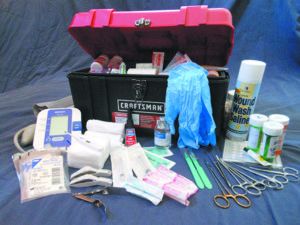
Regarding your recent update to your do-it-yourself medical kit (see PS January 2021, “Updating Your Boat’s Medical Kit”), here’s a tip from my Navy sailing days. In addition to the boat’s primary medical kit, keep readily available a small medical ditty bag to handle minor, common maladies. Stock it with adhesive bandages & tape, antibiotic ointment, splinter tweezers, OTC painkillers & seasickness meds, etc.. You might also include sunscreen and aloe vera gel (for those who were too late on the sunscreen). That way crewmembers or guests can deal with minor scrapes, headaches and such quickly and easily without having to dig out the medical kit, and you know that the medical kit is always fully stocked.
Tim Hohmann
1974 Westerly Berwick
Long Beach, California
Watch for Recycled solvents
A remarkable number of “over-the-counter” volatile solvents and generic diluents used in the marine industry are recycled or recovered products, not virgin materials. Check out the cost difference between reagent or pharmaceutical grade acetone and what the hardware or marine store sells. The good stuff is 5-10 times more expensive.
Here’s a very simple yet effective test to run whenever contaminated solvents are suspected: pour a small puddle of it on a horizontal pane of clean glass and let it evaporate. There should be absolutely nothing on the glass once the solvent is gone.
One contaminate that this test won’t discover is water, quite common in industrial grade solvents, particularly acetone, because it evaporates cleanly.
Diluting gelcoat with acetone, which is mentioned, is never a good idea, because it creates porosity as it evaporates, but adding acetone containing water only makes a successful gelcoat cure even less likely.
Final thoughts: Gelcoat patching aid products reduce its viscosity so it may spray from those anemic PreVal sprayers. Use a proper compressed air powered sprayer or HVLP sprayer. Diluting any expensive paint with a generic solvent instead of the paint formulators specifically recommended solvent is probably a false economy.
Bruce Pfund
Pfund Special Projects
Westerly, RI

As a subscriber, you have free access to our back-issue archive—more than 2,000 articles. Here are a few topics you might find relevant this season.
BATTERY MAINTENANCE
Nothing is so frustrating as starting off the summer with a battery that won’t hold a charge. A new battery is a waste if your system is the root of your woes. For insight into how to prolong battery life see the Inside Practical Sailor blog post “Don’t Kill that New AGM Battery,” as well as our recent battery test (see “Deep Cycle Marine Battery Test,” March 2006), and Andy O’Grady’s advice on extending the life of wet-cell batteries in the October 2008 issue. Our Marine Electrical System ebook, available at www.practical-sailor/books covers everything for lightning protection to batteries and charging systems.
CLEAR PLASTIC

Ultraviolet rays can make quick work of the clear plastic on your cockpit dodgers and enclosures. And some chemical cleaners can actually do more harm than good (see PS July 2015). We sift through the choices for you in several articles that are linked to our Inside Practical Sailor blog post “The Ultimate Guide to Caring for Clear Plastic.” And for a full rundown of all the various cleaning and care concoctions for cleaning and preserving your boat, you can download the complete ebook series, Marine Cleaners, at www.practical-sailor.books.
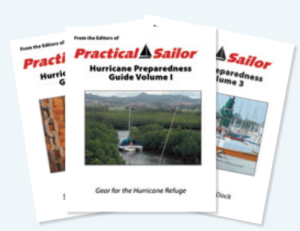
BAROMETER
Whether it’s a replacement barometer you’re looking for (see PS July 2017) or just a how-to guide to the latest meteorological resources available online, you can find it in our archives. Be sure to read our May 2017 report “Marine Weather Forecasting,” which delves into the tools that modern mariners use to get accurate forecasts at sea. If you check in at our online bookstore, you’ll find our newest 3-volume eBook, “Hurricane Preparedness Guide.” Don’t let the name fool you. This comprehensive report will help ensure your moored, docked, or anchored boat is best prepared to survive everything from summer squalls to Mediterranean mistrals.
Great points. PS definitely does not recommend using off-brand solvents to thin LPU paints unless there is no other option, in which case, you should follow our guidance for tracking down and appropriate substitute. Always test first.
A Gasp Reflex “Seatrial?”
Regarding your report on cold water survival (see PS March 2019, “Cold Water Survival”), the breathing reflex when hitting cold water is hard to control. I’ve done some triathlons in Santa Cruz, CA in cold water, and it hit me hard. Now that I know what to expect, I am okay.
Christopher Kilgus
via PS Online
A video with the blog post shows how to adjust to cold water before entering to prevent the risk of gasp reflex, or even heart attack.
A Salmon angler’s Close call
In the 1980s and 90s I fished a 1915 28-foot Monterey, later a 32-foot commercial rigged cutter, trolling for salmon on the North Pacific coast. Like most of the fleet, I was a sole practitioner. There was no one on the boat to turn around and rescue me if I fell over. A common vision occurred to me as the boat rolled along with the auto-pilot on. The boat mounted on a large coil spring on top of the Empire State Building, bobbing and swaying in the wind. A fall overboard would most likely have the same outcome.
Paul Smith
via PS Online
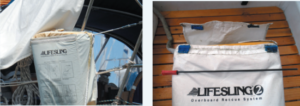
A Nod to Camco Antifreeze
Regarding your Inside Practical Sailor blog on antifreeze “Marine Antifreeze Problems: When Pink Antifreeze Freezes,” the Camco product is great to winterize your entire RV water system, including your refrigerator drinking water dispenser and ice maker. It leaves absolutely no aftertaste. I found this useful last year to protect from freezing/breaking tanks during Minnesota’s winter.
Iris Thomas
Via PS Online
Camco was among the recommended products in our last multi-product comparison of antifreeze solutions (see PS’ Top Picks for Winterizing, September 2014). The blog post also has links to several useful guides on winterizing. Another related report that will be relevant to many northern boaters is our study of the relationship between anti-freeze solution and biological growth in water tanks (see “Will Your Tanks Be Clean Next Spring?” November 2014). For those planning extended cruising in areas where water quality is unreliable, our three-volume ebook series “Onboard Water Treatment, Storage, and
Production,” (www.practical-sailor.com/product/onboard-water-treatment-storage-and-production-complete-series) offers a comprehensive look at this topic.
Prop Cages for Chase Boats
Regarding your Rhumb Lines column in the January 2017 report, “The Tragedy of the Driverless Dinghy, [the fatal chase boat accident was] so very tragic, sad, and life changing to all those involved. The one option not discussed is the cage over the prop on chase boats. These boats have low performance needs and should be expected to be involved with people in the water.
Kip Becker
Via PS Online
Switch to Mid-boom mainsheet?
My mainsheet traveler track is set up in the back of my sailboat, I would like to move it in front of my cockpit dodger. What is the minimum distance from the mast to the mainsheet attachment point to observe when making the switch from end-of-boom to mid-boom sheeting. Can it be done? And is it a good idea?
Marc Meunier
Hullmaster 27
Lac St. Francois, Quebec, Canada
Before abandoning end-of-boom sheeting, consider its advantages. The first is trim. End-of-boom sheeting generally allows for better control of mainsail shape, although the degree to which this impacts performance will vary depending on the boat. For cruising sailors, a persuasive reason to keep end-of-boom sheeting is that mid-boom sheeting increases the risk that the boom might crimp or break as the boat rolls in a beam sea, burying the clew and overloading the point where mid-boom mainsheet attaches.
There are several precautions that sailors can take to prevent this. The most common approach is to rig a well-engineered preventer (see PS July 2017, “The Best Prevention is a Preventer”). We suspect that there is very little risk of you burying a boom on your home waters, 20-square mile Lac St. Francois. So from that perspective your boat is a fine candidate.
The other issue to consider is the engineering of the traveler installation and the consequences if it isn’t done correctly. You not only want to make sure that you have adequately spread the mainsheet traveller loads with a backing plate, but you also want to make sure the holes you drill through the deck are well sealed to prevent any water intrusion into the deck core—assuming it is cored (see PS June 2016 “Through-bolting Fiberglass: An Inquiry into Failure Modes”). The loads on a boat of your size are relatively low, unlikely to test the limits of a good installation.
As for the distance, you want to minimize the distance from the boom end as much as possible. If you have any doubts about the engineering, we’d recommend you speak with a tech advisor from the company that sells you the traveler, and perhaps a local rigger, to make sure the modification doesn’t create problems. One common side-effect of moving the traveler to the coachroof is that it can cause flexing that will gradually open up the seals around windows and portlights, and these leaks can lead to further weakening of the structure that exacerbates the problem.

please send them to the editor. Our last test was featured in the September 2013 issue.
Anshinya Sling Success Story
I enjoyed your article about making the Anshinya sling (see PS January 2021, “Make Your Own Anshinya Sling.” It looked like an interesting winter day project, so I thought I’d give it a try. I already had all the sling materials, so the only cost was my time spent to make it.
I think it turned out pretty good as a test model, but I would use (as you noted) a 3-1/2-inch diameter pool noodle on the next one I build. I also had some yellow nylon ripstop material, so added that as a protective cover. I’m no great sewing machine user, but I do think it added a much more professional look to the finished sling. I really appreciate ideas like these.
Barry Brewer
Seabrook, TX
Marine Spotlight Choices
Regarding your report on marine spotlights, (see “Finding the Bright Spot: Marine LED Spotlights,”September 2013), I used Bigsun Q953, and it was good, too. What impresses me the most in this spotlight is its toughness and durability. Upon inspection, it looks so tough and hard with the ABS construction and
aluminum materials. In terms of the quality of its light, I can say that this spotlight is amazing. It can be used as a spotlight and a floodlight and has the ability to illuminate objects 800 meters in distance. I recently bought a Streamlight spotlight, and I am very satisfied with it. Easy to handle, the light is very bright, and the battery lasts a long time.
Janine Oliver
Via PS Online
Correction
The correct website for the collapsible Oru kayak is www.orukayaks.com. The model we tested was the Beachlite LT ($1200). The online version of the article reflects the correct information (see PS February 2021, “Oru Kayak Opens New Horizons”).
Practical Sailor welcomes reader comments and questions. Send email & reader photography (digital .jpeg 1MB or greater) to [email protected]; include your name, homeport, boat type, and boat name. Send Gear Graveyard samples to PS at 1600 Bayshore Rd., Nokomis, FL 34275






























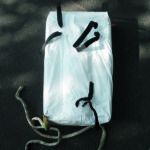 there is a simple fix that doesn’t stick you with short-lived Velcro. Tech Editor Drew Frye devised his own quick-release system by stitching a pair of matching webbing loops, through which a small carbon rod would pass, joining them together (above right). On the back side, some glued patches secure new webbing straps with Velcro to secure to the stern pushpit rails.
there is a simple fix that doesn’t stick you with short-lived Velcro. Tech Editor Drew Frye devised his own quick-release system by stitching a pair of matching webbing loops, through which a small carbon rod would pass, joining them together (above right). On the back side, some glued patches secure new webbing straps with Velcro to secure to the stern pushpit rails.
